The U.S. Navy constantly has an aircraft carrier strike group close to China, based in Japan. Here is the latest news from that ‘permanent’ mission: The crew of another American carrier will be taking the place of the USS Ronald Reagan (CVN-76), which is slated to return to Bremerton, Washington, next year for a planned overhaul.
The Ronald Reagan has the key American naval asset deterring an increasingly belligerent China in the West Pacific. It returned to its homeport in Yokosuka, Japan, following a 93-day deployment that began in May.
The USS George Washington is expected to return to Yokosuka after the Ronald Reagan heads for its overhaul. The George Washington stood on station in the Western Pacific until 2015, when the Ronald Reagan replaced it.
Ronald Reagan Practices Deterrence Against China
The Ronald Reagan spent its most recent deployment engaging in flight operations. It undertook joint fleet operations with the USS Nimitz and its strike group; with the Japan Maritime Self-Defense Force helicopter destroyer JS Izumo (essentially Japan’s first aircraft carrier since World War II); and with two frigates from Canada and France.
The carrier visited Vietnam on June 25 in a show of support for another country in the region that feels threatened by China. It marked one of the first visits to the country by an American aircraft carrier since the Vietnam War.
The carrier participated in the Talisman Sabre exercise with the Australian Navy earlier this month.
“Talisman Sabre gives us another opportunity to maintain and improve upon our ability to integrate seamlessly with our Australian allies to execute complex, multi-domain missions across a vast area,” Rear Adm. Pat Hannifin, commander of Carrier Strike Group 5, said. “In addition to our advanced air and sea exercises, this event provides us valuable space to share best practices with specialists from the Australian intelligence community, building relationships and shared awareness that will pay dividends deep into the future.”
The Australians evaluated how the navies of both nations could practice interoperability.
“We’re getting an even better understanding of how many ways we can support each other. Our ability to share intelligence, share reporting and share data allows us to better prepare for future operations, either interlinked with American forces or actually embedded with a strike group like this,” Cmdr. Darryl Scott of the Royal Australian Navy Information Warfare Force said in a U.S. Navy press release.
China Practices Anti-Submarine Drills
The redeployment of the Ronald Reagan takes place as China carries out naval exercises aimed at keeping the U.S. and its allies at bay.
China’s People’s Liberation Army Navy (PLAN) conducted anti-submarine warfare drills in the South China Sea, practicing how to hunt the submarines of the U.S. and its allies.
“A naval aviation regiment and a submarine detachment affiliated with the PLA Southern Theater Command recently conducted a long-endurance, nonstop exercise on searching and attacking submarines in the South China Sea, the PLA Southern Theater Command said in a press release on Tuesday,” Chinese Communist Party mouthpiece The Global Times reported. “During the exercise that examined the crews’ skills and tactical capabilities, Y-8 anti-submarine patrol aircraft carried out searching, identifying, attacking and tracking of submarines under single or multiple known variables, according to the press release.”
The Global Times noted that the exercise was intended as a counter to the AUKUS pact that aims to provide nuclear submarines to Australia. It added that China sought to counter the stealthy U.S. Seawolf-class submarines. The South China Sea is one of the most inhospitable places to operate submarines due to its shallowness.
John Rossomando is a defense and counterterrorism analyst and served as Senior Analyst for Counterterrorism at The Investigative Project on Terrorism for eight years. His work has been featured in numerous publications such as The American Thinker, The National Interest, National Review Online, Daily Wire, Red Alert Politics, CNSNews.com, The Daily Caller, Human Events, Newsmax, The American Spectator, TownHall.com, and Crisis Magazine. He also served as senior managing editor of The Bulletin, a 100,000-circulation daily newspaper in Philadelphia, and received the Pennsylvania Associated Press Managing Editors first-place award for his reporting.
From the Vault
The Navy Sent 4 Battleships To Attack North Korea
‘Sir, We Hit a Russian Submarine’: A U.S. Navy Sub Collided with a Nuclear Attack Sub

